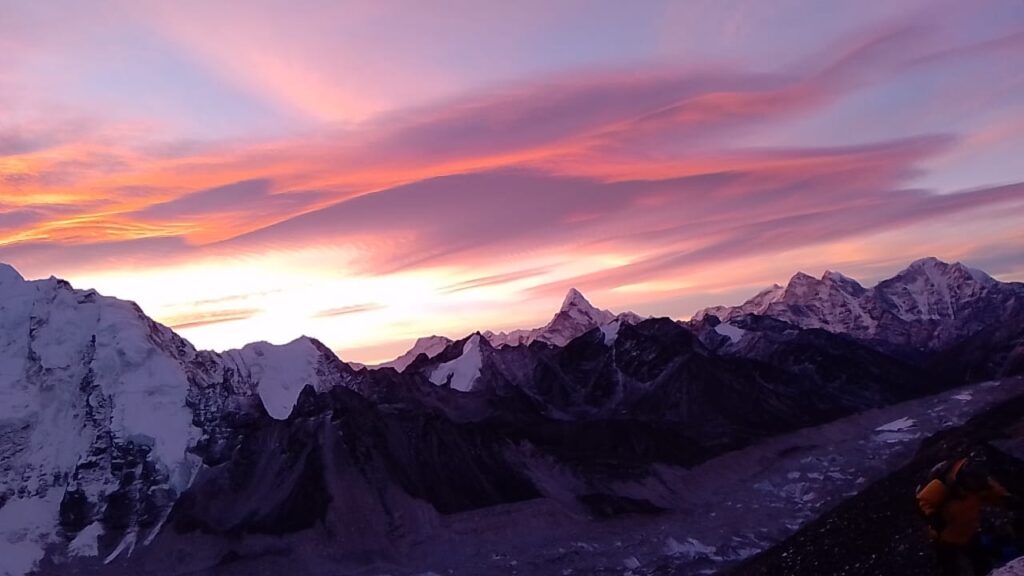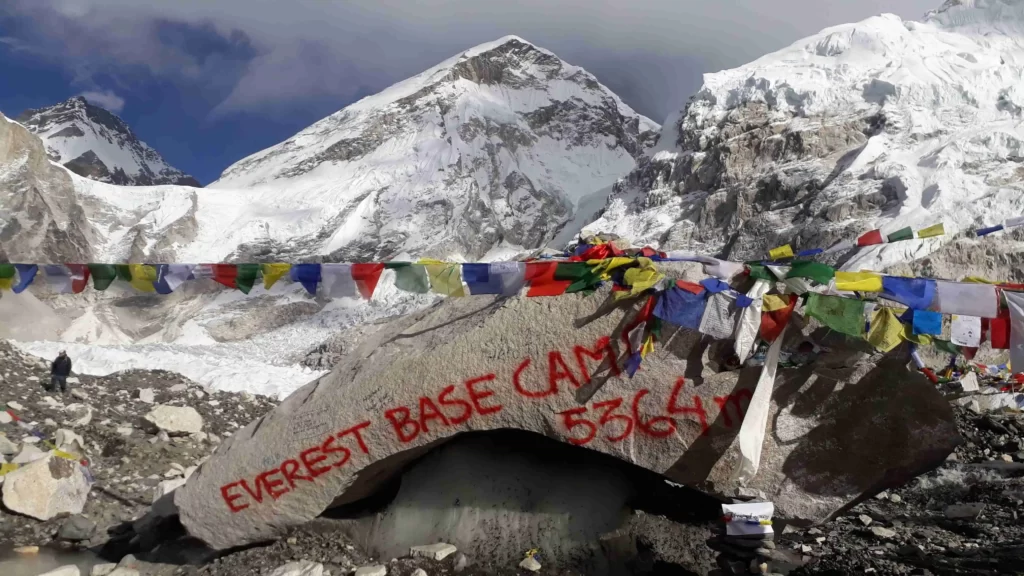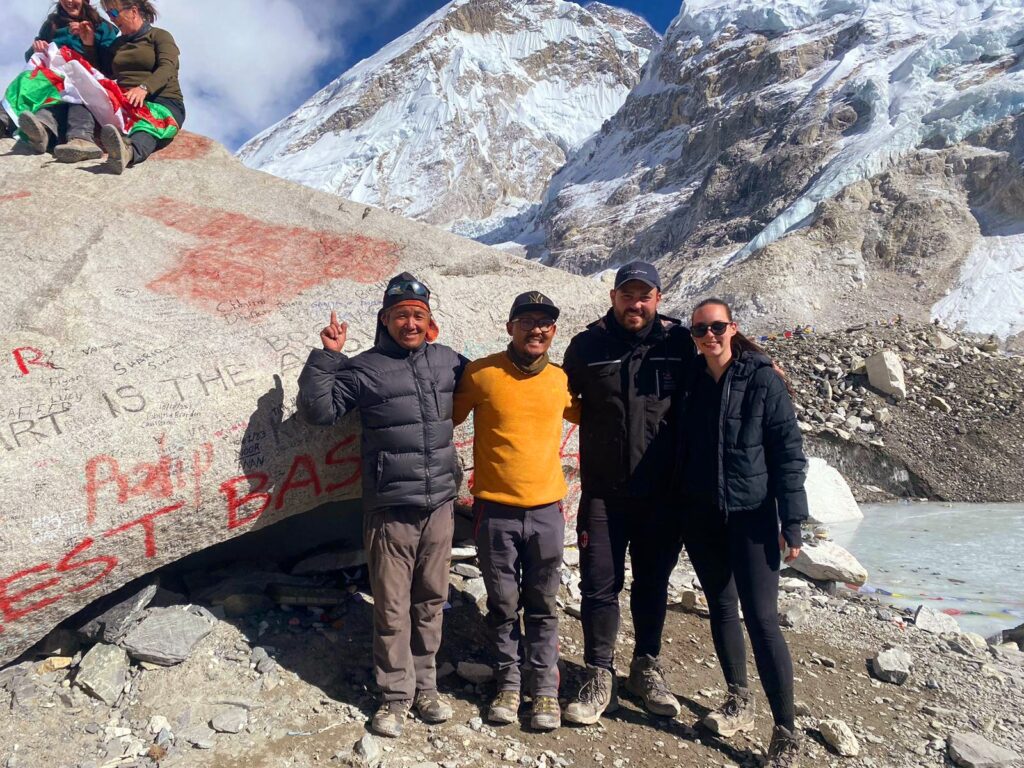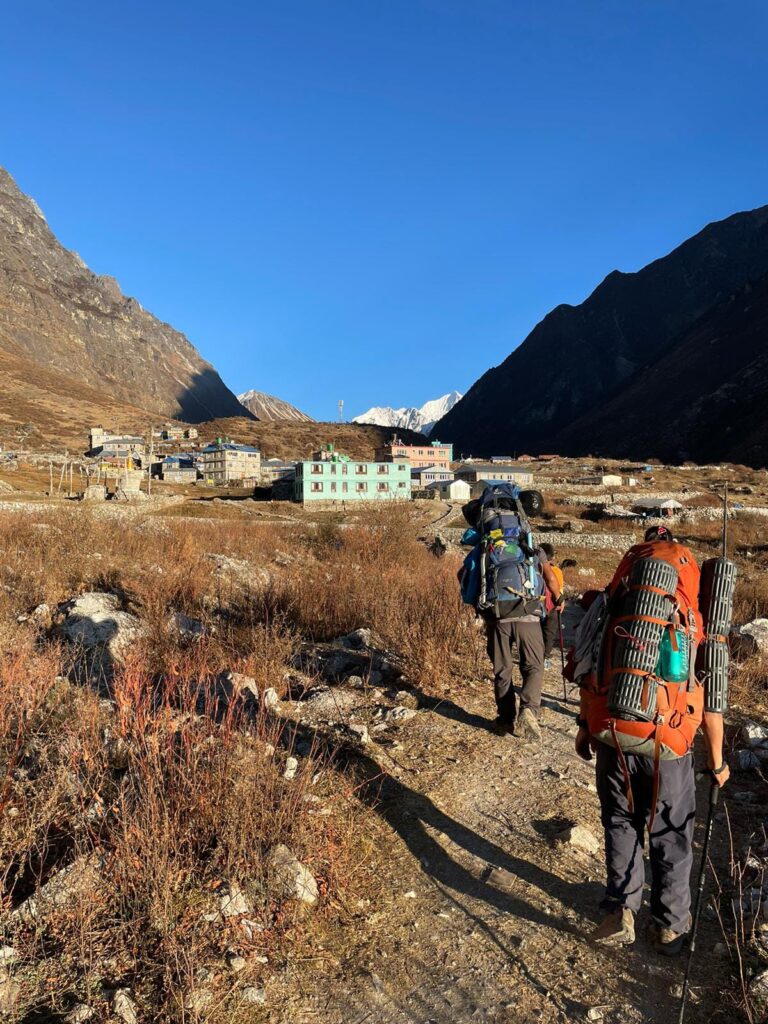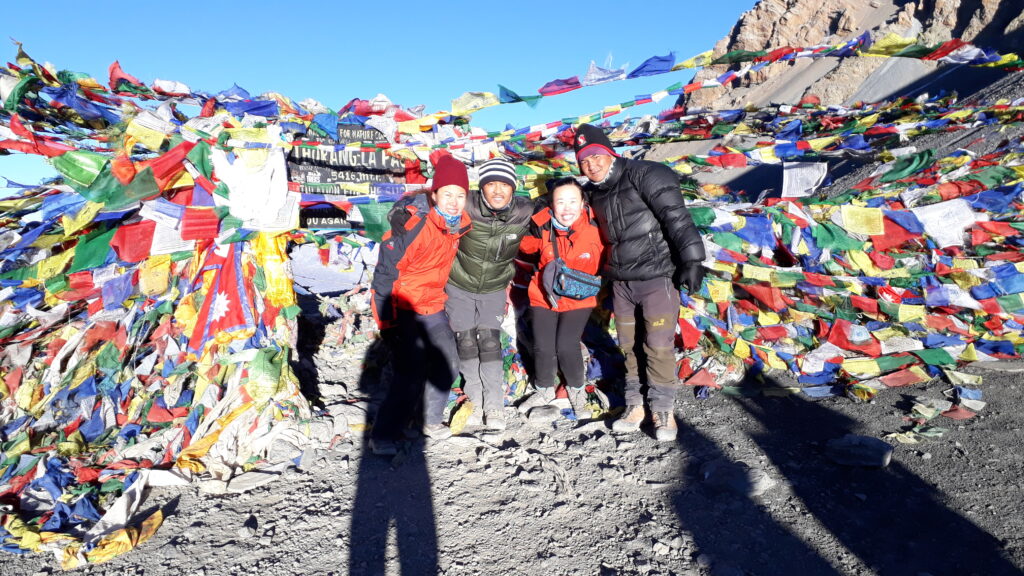Everest Base Camp Trek

Destination
Everest Region

Duration
15 Days

Grade
Moderate

Max Altitude
5,550m

Group Size
2-18 Pax

Meal
All Inclusive

Activity
4-6 hrs

Accommodation
Hotel/Teahouse

Season
Autumn/spring
Description
Everest Base Camp Trek
Sherpa Expedition Guide And Adventure warmly greeting from land of Himalayan in Nepal.
The Everest Base Camp Trek is one of the most iconic and popular trekking adventures in the world. It takes you through the heart of the Khumbu region in the Nepalese Himalayas, offering stunning landscapes, charming Sherpa villages, and breathtaking views of some of the world’s highest peaks.
Everest Base Camp Trek
Sagarmatha National Park: The trek begins in Lukla and passes through Sagarmatha National Park, a UNESCO World Heritage Site known for its diverse flora and fauna.
Namche Bazaar: This bustling Sherpa town is a gateway to the Everest region and provides trekkers with their first acclimatization stop. Namche offers markets, teahouses, and stunning views of Everest.
Tengboche Monastery: A culturally significant stop, Tengboche is home to an ancient monastery with panoramic views of Ama Dablam, Everest, and other peaks.
Kala Patthar: A viewpoint near Everest Base Camp, Kala Patthar offers a spectacular panoramic view of Mount Everest, Nuptse, and Lhotse.
Everest Base Camp: The ultimate destination of the trek, Everest Base Camp allows trekkers to experience the base of the world’s highest peak and witness the activities of climbers preparing for their ascent.
Practical Tips
Acclimatization: Adequate acclimatization is crucial to prevent altitude sickness. The trek includes strategic acclimatization days at higher elevations.
Permits: Trekkers need a Sagarmatha National Park entry permit and a TIMS (Trekkers’ Information Management System) card.
Weather: The trek is best undertaken during the pre-monsoon (spring) and post-monsoon (autumn) seasons for clear skies and pleasant temperatures.
Packing: Pack essentials such as warm clothing, a good pair of trekking boots, a reliable backpack, and necessary documents. Be prepared for a range of weather conditions.
Guides and Porters: Hiring a local guide and/or porter can enhance the trekking experience and help with logistical challenges, allowing trekkers to focus on the journey.
Tea Houses: Accommodation along the trail is typically in tea houses, providing a chance to experience the local culture and hospitality.
Remember that trekking in high-altitude areas involves physical exertion, so it’s essential to be adequately prepared and aware of your own health and fitness. Always check the latest travel advisories and permit requirements before embarking on the Everest Base Camp Trek.
Itinerary
Upon your arrival in the Kathmandu airport (KTM) you will be greeted by a representative from Alliance Trekking (AT). After completing your custom formalities (Visa, etc) pick up your luggage and look for our representative with a Alliance Trekking display board at the arrival gate. You will be then transferred to Hotel Manang or a similar category hotel. After check in, you will visit our office, meet your trekking guide as well as other participants and do final preparation for the trip. Later in the evening we will organize a “Welcome Dinner” at an excellent traditional Nepalese Restaurant where you will enjoy a Nepalese cultural program along with a fine meal.(D).
Take your breakfast at the same hotel and then at 9:00AM by a private car start your Kathmandu Valley sight seeing of Bouddha Nath Stupa – the world’s largest stupa, a sight of great reincarnation to the Buddhist. It’s then off to Pasupatinath temple – the most sacred of the Hindu Temple in Nepal dedicated to lord Shiva. Built in 1696. we will stop by at Patan for your lunch and after sight seeing tour of Patan Durbar Square – a city of architecture and fine arts. This city is known as the second oldest city in Kathmandu and Patan museum is the best museum in the South Asia. It is said that Krishna temple was made of a single stone. Visit the famed Golden temple, Patan palace square along with local market street visit. Our next stop is Swoyambunath Stupa/Monkey temple – the oldest Buddhist shrine. Looking east from on top, one can see the entire Kathmandu Valley spread out below. The front way is over 300 steps to get on the top of the Stupa makes for an interesting walk. This place is also the best for sunset views over the mountains. Over night at hotel. In the evening at 5:00 PM, we meet at our head office for a briefing about your trip program. We will hand over your trekking documents- flight ticket, permits, trek itinerary, check equipments and introduce you to your trekking guide. (B)
After breakfast, early morning we get transferred to the domestic terminal of Kathmandu airport for an early morning flight to Lukla (2,800m/9,186ft), a gateway destination from where our trek starts. After an adventurous 40 minute flight above breathtaking green and white mountains, we reach the Tenzing-Hillary Airport at Lukla. This is one of the most beautiful air routes in the world culminating in a dramatic landing on a hillside surrounded by high mountains peaks. Here we meet our other crew members and after some packing and arrangements, we start our trek through the prosperous village of Lukla until we reach Phakding. To assist in acclimatization, we only have a short hike today. However, if interested in additional activities. we can take a side trip to a nearby monastery. Overnight in Phakding. Included meals: Breakfast, Lunch, Dinner (B,L,D)
Walking through a beautiful pine forest, the track leads us along the Dudh Koshi River across numerous suspension bridges. One of which is the famous Hillary Suspension Bridge. We catch wonderful view of the glistening Mt. Thamserku (6618 m). Through the settlement of Benkar, Chumoa, Monjo, we come to the check post and entrance to Sagarmatha National Park. We pass through the last village of Jorsale before reaching Namche Bazaar. The trail climbs through the forests and bridges until we reach the confluence of the Dudh Koshi and Bhote Koshi rivers. After a final steep ascent of about two hours we get first sight of Mt. Everest peering over the Lhotse-Nuptse ridge. We pause in our trek at Chautara to admire the view. We still need to hike about 1.5 hours to reach Namche Bazaar, a gateway to Base Camp and main trading centre of this region. We stay overnight in Namche Bazaar.(B,L,D)
This is the scheduled ‘acclimatization’ day for this trek. Health experts always recommend us to stay active and moving during the rest day rather than being idle. We either spend the day taking a day hike to Thame or visiting Khunde or relaxing and exploring Namche Bazaar itself. Namche Bazzar is the main centre of the Khumbu region and has government offices, ATMs, Internet cafes, shops, restaurants, a bakery and a colorful market each Friday evening and Saturday. If we trek a few hundred vertical feet during the day, it will help us to properly acclimatize. Our guides will take us to the Tourist Visitor Center near the headquarter of the Sagarmatha National Park where we can observe an assortment of things related to the first climbers, Sherpa culture and learn about the various plant and animal life of the this region. We also take an interesting side trip up to Khumjung. We climb up to the famous airstrip at Syangboche. Just above the airstrip is the Everest View Hotel, a Japanese scheme to build a deluxe hotel with great views of the highest mountains on Earth. The Khumjung valley is surrounded by the snowy peaks of Kongde and Thamserku and the sacred peak Khumbila, hosts a well known monastery that houses a yeti scalp. We also visit the Hillary School which is at the same site. After having lunch and spending some time in Khumjung, we walk back down to Namche Bazzar. Overnight in Namche Bazaar. (B,L,D)
After breakfast in Namche, we start our trek towards the village of Tengboche, enjoying superb views of Mt. Everest, Nuptse, Lhotse, Ama Dablam and close up view of Thamserku. Our trek follows on the gradual trail with few ups and downs overlooking magnificent views of the great Himalaya. Along the way we can spot wildlife like pheasant, musk deer, or a herd of Himalayan Thar. The trail goes gradually down up to Kayangjuma. The path eventually reaches Sansa which is the major trail junction to Gokyo valley and Everest Base Camp. The track then follows through the pine forests and after we cross the prayer flags festooned bridge over Dudh Koshi River, we reach Phunki Thenga, a small settlement with a couple of teahouses and a small army post amidst the alpine woods. After having a relaxed lunch at Phunki Thenga, we experience a slightly tough climb up through the pine forests while before we reach Tengboche. Tengboche is a great place for close up views of Ama-Dablam, Nuptse, and Everest and it has a biggest Buddhist Monastery all over in Khumbu region. We visit the monastery the same day at around 3 p.m. to witness the ceremony in the principal and popular monastery of the region. Over night stay at lodge in Tengboche.(B,L,D)
With the mountains as a backdrop, the monastery in Tengboche looks spectacular in the morning sun. We snap pictures of the monastery and the scenery and as usual, begin our day’s journey. We choose the upper trail for better views to visit Pangboche village and its ancient Monastery. We pass through several Chortens and Mani walls and small villages. We enjoy lunch with fantastic close-up views of Ama-Dablam. In the afternoon, we move north to Pheriche or take the eastward trail beneath the towering north face of Ama Dablam. From here onwards the walk is fairly moderate as we enter the Imja Valley. The valley ahead will begin to open up as we approach the confluence of the Lobuche River. We descend into the river and begin the last and steepest climb of the day up to Dingboche. On arrival in Dingboche, we enjoy the beautiful array of fields enclosed by stone walls to protect the barley, buckwheat and potatoes from the cold winds and grazing animals. Overnight in Dingboche. (B,L,D)
After having breakfast your hiking to nagajung is being started. Dingboche to Nagarjung View Point offers a breathtaking trekking experience in the heart of the Himalayas. As you ascend from Dingboche, you’ll be surrounded by stunning landscapes, including towering peaks and picturesque valleys. The trail takes you through diverse terrain, from alpine meadows to rocky paths, providing a mix of challenges and rewards.
Nagarjung View Point, situated at a higher elevation, promises panoramic vistas of the surrounding peaks, including Ama Dablam, Lhotse, and Everest. The journey involves navigating through Sherpa villages, where you can experience the local culture and hospitality. Don’t forget to acclimatize properly to the altitude as you gain elevation, ensuring a safe and enjoyable trekking experience
We start the day with a climb to Duglha through the Khumbu Khola valley. The trek along the arid terrace is awarding with awesome views of mountains on all sides. As we come to a yak herder’s place called Dusa, the valley begins to narrow and we continue through Phulung Karpo. THis is one of the camp sites during first successful Everest Expedition in 1953. Above Phulung Karpo is Chola Lake. As we continue our trek as the majestic view of Mt. Pumori (7138 m/ 23418 ft) comes into view. As the trail descends and curves hiding Mt. Pumori as we come across a roaring stream. After crossing a small wooden bridge, we ascend to Dugla is lunch sport, Beyond Duglha we trek up the steep terminal moraine of the Khumbu Glacier. We find our way through the boulder-strewn slope as we ascend Chupki Lhara, an eerie ridge top with dramatic mountains views. At the top of the ridge we will find an array of stones with prayer flags used as memorials to Scott Fischer (American mountaineer) and 10 times Everest submitter Babu Chiri Sherpa (mountain guide from Nepal) who perished on a mission to climb Everest. As the trail drops to the Khumbu Glacier moraine, we find ourselves right “in front of” several great peaks – Khumbutse, Lingtren, Pumori and Mahalangur Himal. We are now in the vicinity of Everest, but the great mountain still remains hidden. Nuptse towers to the right as the trail crosses the Khumbu Glacier. As we trek along a murmuring stream we do not see the Khumbu glacier because of its lateral moraine wall and we now begin to feel a little out of breath due to high altitude. Overnight in Lobuche.
The trail to Gorak Shep goes ahead through the lateral moraine of the Khumbu Glacier. We pass though the pyramid sign post. Ahead on the trail we see crest of the north ridge of Everest along with Mt. Pumori, Mahalangur, Lingtern, Khumbutse, Nuptse, etc. A small ascent would take us to Thangma Riju from where we perceive 360 degree vista of snowy mountains. Climbing steeply up to the top through the torrent of Changri glacier, we catch our first glimpse of Kala Patthar, a grey-green knoll beneath the Mt. Pumori. As we reach Gorak Shep, we will be surrounded by snow-capped mountains looming all around us including the top of the world – Mount Everest. After a brief lunch and rest, we take the trail to Base Camp through the once vast Gorak Shep Lake. Continuing straight ahead, we come through the Indian army mountaineers’ memorials. As we reach Everest Base Camp, we cannot stop ourselves from appreciating the Everest climbers who took the hazardous route through the Khumbu icefall. Mountaineer’s tents stand out in bright colors against all the dull gray surroundings (especially in the Spring). Nuptse, Khumbuste and Pumori are the mountains we can view from base camp. By now we have met the ultimate objective of our trip. However, the sunset view from Kala Patthar is more admirable than the sunrise view, so it is suggested to visit Kala Patthar today during sunset. As the setting sun’s rays strike the snow capped mountains the resulting scenery is indescribable. For those trekkers who wish to continue to Kala Patthar, our guides and Sherpas coordinate your hike to Kala Patthar for amazing sunset view today rather than waiting until the next day. Overnight in Gorak Shep at a local lodge. Breakfast, Lunch, Dinner Included
Today is the climax of our trip. We start early in the morning to catch the dramatic views from Kala Patthar witnessing the first light of day shining on Mount Everest. However, we need to get prepared for an early morning as it is dark and the morning temperatures are cold (-10 to -14 C) departure beforehand. Plus there is always the potential for chilly winds which are quite common. Familiar peaks such as Lingtren, Khumbutse, Changtse tower to the east even as Everest begins to reveal itself emerging between the west shoulder crest and Nuptse. During the ascent to Kala Patthar, we pause to catch our breath at several outstanding view points to snap pictures. After several hours of an ascent, we reach Kala Patthar. From here we scramble to climb the rocky outcrop near to the summit marked by cairns and prayer flags. As we reach the top, we sit on the Kala Patthar rocks as our eyes take in the unbelievable Himalayan Panorama, wandering from one mighty massif to another. We take as many pictures as we can with our camera while the incredible view will be in our minds for a lifetime. On being back to Gorak Shep, we have breakfast and wait for other participants to return back. Those participants who will visit Everest base camp today will have early breakfast to start early as Everest base camp hike takes longer time (4-5 hrs) than the Kala Patthar hike. Upon return back to Gorak Shep, the group will have lunch together; and afternoon time is taken to descend down to Pheriche for a good night’s rest. Breakfast,Lunch, Dinner Included,
We will trek down through the hillside blanketed by rhododendron and juniper trees. If it’s spring, pink and red rhododendron flowers ablaze in our surroundings. Depending on our hunger and condition, we either have our lunch in Pangboche or wait until we reach Phunki Tenga for lunch. After crossing the prayer flag festooned bridge over the Dudh Koshi River, the trail follows the Dudh Koshi gorge descending rapidly through the pine forests. The path eventually reaches Sansa which is the major trail junction in the region. We stop at Kyangjuma (3570 m/11,710 ft) for a relaxed lunch. We unknowingly appreciate the gorgeous Ama Dablam, Thamserku and Nuptse with every bite. Following lunch, the trail to Namche Bazaar clings to the steep wooded slope beyond Kyangjuma, winding through several bends. We keep a lookout for wild life such as mountain goats, snow leopards, colorful pheasants, etc., while we pass through the forest on the trail. After passing a Chorten, we reach the army camp at of Namche Bazaar. We want to take a long last look (and picture!) back to Lhotse, the tip of Everest and Tengboche from here. On reaching our lodge, we take a nice hot shower and have very relaxed sleep in our room in Namche Bazaar. Overnight in Namche Bazaar Breakfast, Lunch, Dinner Included.
The trail descends steeply downward so we need to walk slowly and under control as our shaky legs continuously battle the rocky terrain. After crossing the suspension bridges over the fast flowing Dudh Koshi and its tributaries the trail becomes more levell. By today we start to get warmed up by the light breeze. Any remaining sore throats and colds will be gone by today as we pass through this charming mountain air. Although we are travelling the same route down, we see completely different views. We snap a mixture of open plains, rhododendron and pine forests, and in the distance snow covered peaks. We walk through the Sherpa villages’ noticing the impressive faith of Buddhism and culture of prayer stones and prayers flag while we walk through the villages. On arrival in Lukla, we stretch those sore legs and recall the experiences of the last couple of weeks. We experience the culmination of a fantastic trek on a happy note with everyone back safe and sound with a smile on their faces! Overnight in Lukla. (B,L,D)
We fly back to Kathmandu after our long mountain journey. The early morning flight drops us at Kathmandu. You can rest and relax throughout the day in your hotel. If you;d like to take some gifts home from Nepal for friends and relatives, visit to some nearby shops or venture out in Thamel for typical Nepalese goods which can be assisted by our guides or you can do it yourself too. If you want to explore any other areas of Kathmandu take the time to do that today! Remember, we will be hosting a fantastic celebration dinner together for successfully completing your trek to Everest Base Camp! Overnight in Kathmandu. (B,D)
You are saying good bye to the mountains as your journey in Nepal comes to an end today! There is nothing to do but trade e-mails with your travel companions and organize your photos. If you have more time you can do some shopping or sightseeing. Approximately 3 hours before your scheduled flight a representative from Alliance Trekking will take you to the airport. On your way home you’ll have plenty of time to plan your next adventure in the wonderful country of Nepal. (B) In some circumstances we can face problem of internal flights to/from Lukla delayed by few hours or canceled for a day or many days too because of bad weather. Very rarely, but it could happen even in best trekking season also as you know how climate change is effecting our globe. Thus, we always recommend you to add supplement night/s in Kathmandu after your trek if possible (just in case).If everything runs smoothly, you can enjoy other activities like sightseeing, rafting , wildlife activities, shopping, as you wish in those additional day. However, if you want heli rescue in the state of flight cancellation to/from Lukla-we can organize it. A helicopter charge around USD 5000 and it can lift 4 persons per flight.
Cost Includes
- Airport pick-up and transport to the hotel by private car
- Kathmandu sightseeing with a tour guide by private car.
- Kathmandu-Lukla-Kathmandu Ramechhap-Lukla-Ramechhap flights with private airport transportation, domestic airport tax, and domestic ground transportation.
- City Hotel accommodation for 2 nights in Kathmandu with breakfast, twin sharing room.
- All meals During The Trek (breakfast, lunch, dinner, and tea) during the trek.
- Fresh fruit after dinner daily.
- Accommodation in mountain lodges/tea houses during the trek.
- Sagarmatha National Park Entry Permit & Khumbu Pasang Lhamu Rural Municipality fees.
- Government-licensed, Good English-speaking guide
- All Staff wages covering food, drinks, accommodation, transportation, and insurance.
- Sherpa helper for carrying baggage (1 helper for two clients) with proper safety equipment, wages, food, drinks, accommodation, and insurance.
- Availability of a first aid kit.
- water purification tablets for tap water, ensuring safe drinking water throughout the journey.
- Emergency helicopter services covered by your travel insurance.( Incase If Needed )
- All government taxes and official expenses.
- Equipment Provides If Needed, sleeping bag, down jacket, duffel bag, and trekking poles (to be returned after the trip if needed).
- Oxygen meter fo checking pulse, oxygen Level(AMS)Acute Mountain Sickness.
- All Necessary Assistant guide for groups of 8.
Cost Exclude
- additional accommodation in Kathmandu Foods, drinks Everything
- Nepal entry visa fee, visa is obtainable on arrival at Tribhuvan International Airport in Kathmandu).
- Travel and medical insurance.
- International airfare Tickets
- Desserts and sweet items like chocolate, cake, pie, pudding.
- Excess Baggage and luggage weight is 10-15 kg maximum
- Hot showers, battery charging, and use of Wi-Fi in tea houses.
- During The Trek Period Like, Hot showers, Mobile, Camera, Power Bank battery charging, Wi-Fi in tea houses.
- Tips for guide and porter, how you feel happy (more expectation)
- Kathmandu sightseeing monument entrance fees ($30 USD per person).
Essential Gear Checklist
Clothing:
- Comfortable Daypack with a waterproof bag cover
- Comfortable Trekking Boots
- Comfortable Sports/Light Shoes
- Several pairs of comfortable T-shirts
- Sandals
- 3-4 pairs of normal and warm socks
- Comfortable Trekking Pants
- Thin layers for comfort
- Warm layers for insulation
- Waterproof jacket and pants for comfort
- Warm hat and sun cap
- Thin and warm gloves
- Sunscreen
- Sunglasses
Gears Provided (If Needed But Should Be returned after the trip)
- Warm sleeping bag
- Down jacket for warmth
- Trekking poles for support
- Trekking Duffel Bag
- Water bottle for hydration
- Water purification tablets

